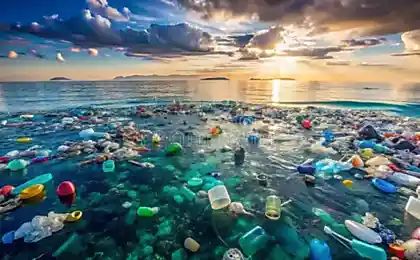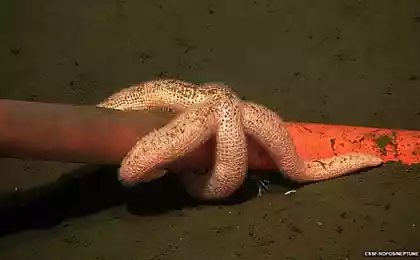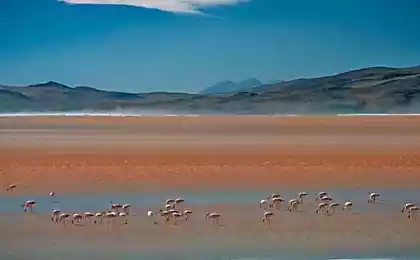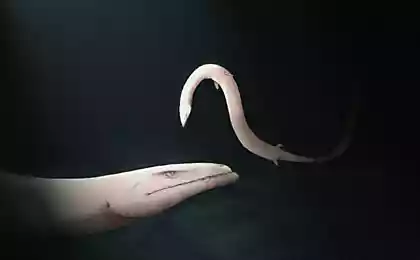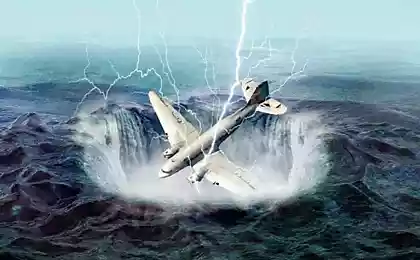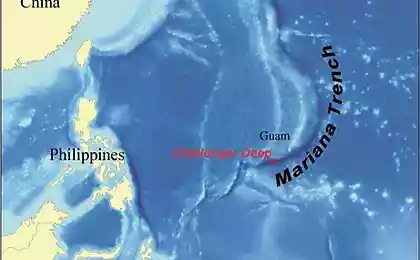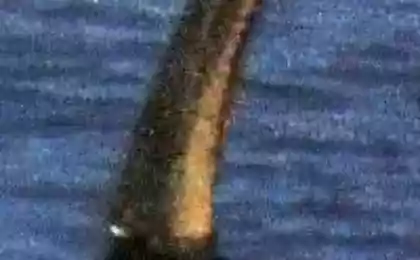833
Secrets of the Ocean
1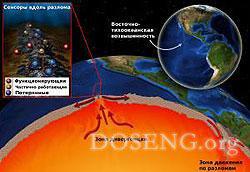
Scientists have recorded eruption of magma at a depth of 2500 meters below the surface of the Pacific Ocean in January 2006. The result has been an increase in the surface of the ocean floor, which was first observed in the process.
Driving the eruption site, and of the processes (image NSF)
According to the researchers, it warned of an impending eruption increased from 2003 to 2005, the seismic activity in the area. Confirmation was obtained by scientists in aprede 2006 survey aboard Korablin "Knorr" 12 seismometers installed on the ocean floor to monitor earthquakes in the tectonic plate boundary of the East Pacific hill in the south of the Gulf of California.
The survey found only four of the sensors 12, whereas in the previous experiments seismometers found in 98% of cases. These seismometers used in the program RIDGE 2000 to study the formation of new ocean floor at the East Pacific hill.
During the eruption of an underwater ocean water is heated by magma jets spurting out of fractures in the crust, and rises to 200-250 m above the bottom in the form of structures, similar to the clouds. In spring 2006, such "cloud of water" were recorded at 6, 5 km south of the eruption.
During the last eruption, scientists have measured the chemical composition of the fluid coming out of the holes, comparing the data with the eruption that took place in 1991. As a result, changes in the installed underwater magma. In the most active volcanic regions stones were thrown from the bottom and surface of basaltic rocks and glassy rainbow shone, indicating a recent cooling of hot magma in contact with ocean water, the official website NSF.2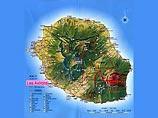
Microbiologists and genetics from the United States and Canada, published the results of the first large-scale study of viruses that live in the ocean.
The researchers used a metagenomic analysis technique - DNA extraction from water samples and comparing it with current genetic databases.
Scientists have processed 184 samples of sea water taken at depths ranging from 0 to 3200 m in 68 points in the Sargasso Sea, the Gulf of Mexico, the Arctic Ocean and in the Pacific Ocean off the coast of British Columbia. It was found that live in the ocean hundreds of thousands of DNA-containing viruses, most of which are unknown to science.
The number of viral particles per liter of ocean water may reach hundreds of millions. Basically it bacteriophages - bacteria parasites. They are able to change the properties of marine bacteria, causing mutation and carrying out gene transfer from one bacterial species to another. Apparently, sea viruses play an important role in the planetary cycle genes and substances energii.3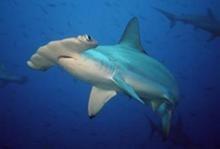
According to scientists, ichthyologists, in the north-western part of the Atlantic Ocean they were able to discover a new kind of a hammerhead shark.
This shark is similar to the previously known form of bronze fish-hammer, but so far scientists have not classified it and did not give her name. They think that it is found only in the coastal waters of South Carolina.
American ichthyologists agree that this new rare species on the verge of extinction, and steps should be taken to conserve and protect females during rearing pups.
New shark discovered during the study of fish in the coastal waters of a biology professor at the University of South Carolina, Dr. Joe Quattro, the BBC reports.
Genetic analysis has shown that a new "cryptic" species that "genetically different" from the bronze fish-hammer.
Dr. Quattro discovered that a shark is found only in the coastal waters of South Carolina, and only a few adults swim in Florida and North Carolina.
"If South Carolina's waters are the main breeding place of the mysterious species, and females swim here for the rearing, it is this area must be protected in the first place," - says Dr. Quattro.
Now scientists are going to mark the shark sensors to learn more about its hierarchy of these fish.
Currently ichthyologists known about the existence of 454 species of sharks. However, every year in the world of open two-three species, so it is possible that in the near future science waits another discovery.
Photo: The new "mysterious" look "genetically different" from the bronze fish-hammer 4
Radar satellite images obtained by radar ASAR Envisat satellite and the AMSR-E satellite Aqua, have revealed ice-free wormwood representable hitherto sizes - from the Swedish archipelago of Svalbard and the North Pole.
Polynya goes deep into the Russian sector of the Arctic, with an area larger than the British Isles.
Nothing like in the Arctic had never seen, highlights Space Daily. The emergence of a vast, ice-free open water at the North Pole of the planet and indicates the seriousness and scale of the place before our eyes climate change

Scientists have recorded eruption of magma at a depth of 2500 meters below the surface of the Pacific Ocean in January 2006. The result has been an increase in the surface of the ocean floor, which was first observed in the process.
Driving the eruption site, and of the processes (image NSF)
According to the researchers, it warned of an impending eruption increased from 2003 to 2005, the seismic activity in the area. Confirmation was obtained by scientists in aprede 2006 survey aboard Korablin "Knorr" 12 seismometers installed on the ocean floor to monitor earthquakes in the tectonic plate boundary of the East Pacific hill in the south of the Gulf of California.
The survey found only four of the sensors 12, whereas in the previous experiments seismometers found in 98% of cases. These seismometers used in the program RIDGE 2000 to study the formation of new ocean floor at the East Pacific hill.
During the eruption of an underwater ocean water is heated by magma jets spurting out of fractures in the crust, and rises to 200-250 m above the bottom in the form of structures, similar to the clouds. In spring 2006, such "cloud of water" were recorded at 6, 5 km south of the eruption.
During the last eruption, scientists have measured the chemical composition of the fluid coming out of the holes, comparing the data with the eruption that took place in 1991. As a result, changes in the installed underwater magma. In the most active volcanic regions stones were thrown from the bottom and surface of basaltic rocks and glassy rainbow shone, indicating a recent cooling of hot magma in contact with ocean water, the official website NSF.2

Microbiologists and genetics from the United States and Canada, published the results of the first large-scale study of viruses that live in the ocean.
The researchers used a metagenomic analysis technique - DNA extraction from water samples and comparing it with current genetic databases.
Scientists have processed 184 samples of sea water taken at depths ranging from 0 to 3200 m in 68 points in the Sargasso Sea, the Gulf of Mexico, the Arctic Ocean and in the Pacific Ocean off the coast of British Columbia. It was found that live in the ocean hundreds of thousands of DNA-containing viruses, most of which are unknown to science.
The number of viral particles per liter of ocean water may reach hundreds of millions. Basically it bacteriophages - bacteria parasites. They are able to change the properties of marine bacteria, causing mutation and carrying out gene transfer from one bacterial species to another. Apparently, sea viruses play an important role in the planetary cycle genes and substances energii.3

According to scientists, ichthyologists, in the north-western part of the Atlantic Ocean they were able to discover a new kind of a hammerhead shark.
This shark is similar to the previously known form of bronze fish-hammer, but so far scientists have not classified it and did not give her name. They think that it is found only in the coastal waters of South Carolina.
American ichthyologists agree that this new rare species on the verge of extinction, and steps should be taken to conserve and protect females during rearing pups.
New shark discovered during the study of fish in the coastal waters of a biology professor at the University of South Carolina, Dr. Joe Quattro, the BBC reports.
Genetic analysis has shown that a new "cryptic" species that "genetically different" from the bronze fish-hammer.
Dr. Quattro discovered that a shark is found only in the coastal waters of South Carolina, and only a few adults swim in Florida and North Carolina.
"If South Carolina's waters are the main breeding place of the mysterious species, and females swim here for the rearing, it is this area must be protected in the first place," - says Dr. Quattro.
Now scientists are going to mark the shark sensors to learn more about its hierarchy of these fish.
Currently ichthyologists known about the existence of 454 species of sharks. However, every year in the world of open two-three species, so it is possible that in the near future science waits another discovery.
Photo: The new "mysterious" look "genetically different" from the bronze fish-hammer 4

Radar satellite images obtained by radar ASAR Envisat satellite and the AMSR-E satellite Aqua, have revealed ice-free wormwood representable hitherto sizes - from the Swedish archipelago of Svalbard and the North Pole.
Polynya goes deep into the Russian sector of the Arctic, with an area larger than the British Isles.
Nothing like in the Arctic had never seen, highlights Space Daily. The emergence of a vast, ice-free open water at the North Pole of the planet and indicates the seriousness and scale of the place before our eyes climate change


